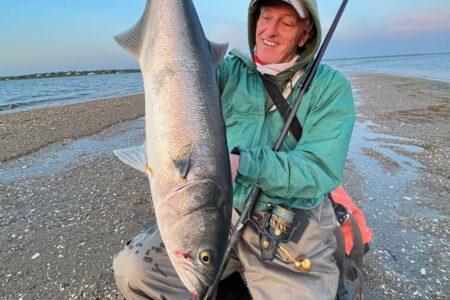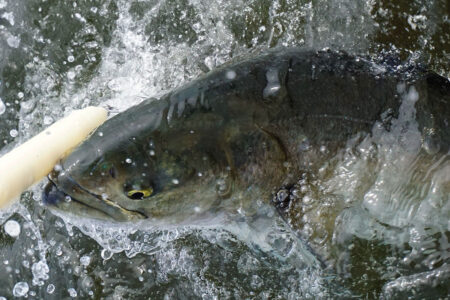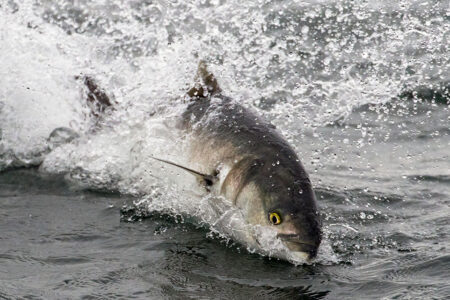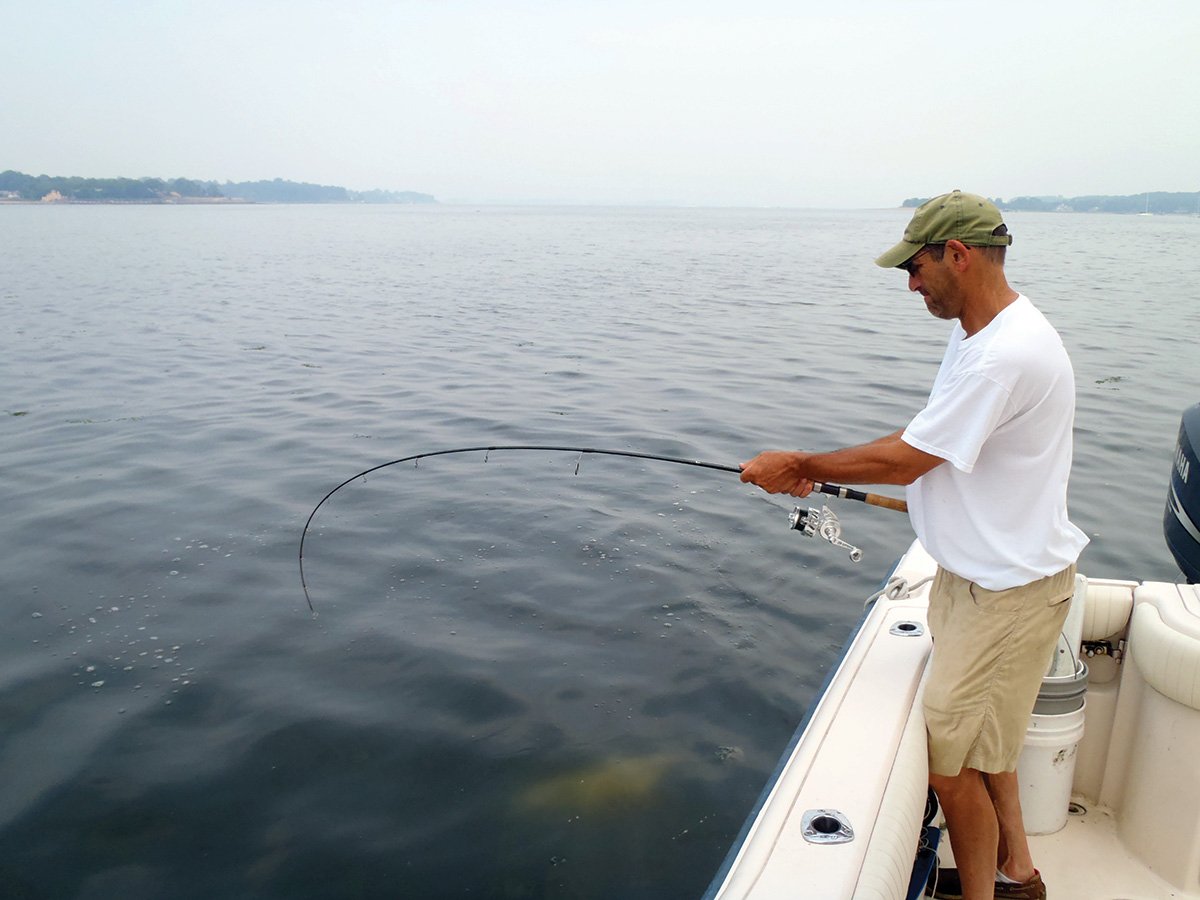
Bluefish are frequent late summer and fall visitors to Long Island Sound harbors, drawn to the shallows by an abundance of bait. They are an odd fish in a way: a pelagic (ocean) species that at times invades the skinny water in the backs of our harbors. The closest we come to that behavior are false albacore and bonito, and although they frequent Sound waters, they rarely venture very deep into the harbors. Thus, blues seem to be an oceanic species that also likes the lower salinity of the estuary: unlike false albacore and bonito.
Well I’m glad they enjoy a good romp in the harbors because I love catching big bluefish, and the calm shallows in the backs of the harbors offer an opportunity to catch them on light tackle. True, light tackle limits our lure choices to mini versions of soft baits, bucktails, tins, and hard plastics, and each lure has its charms and its season. However, as late summer arrives and young of the year baits grow to 1 to 3 inches, an opportunity arrives to catch the fish on hard plastic surface lures such as poppers and pencil poppers. I enjoy all of the techniques mentioned above, but there’s just something special about catching a teen-size blue on a surface lure in barely enough water to float your boat.
Key Factors
Success is always dependent on a confluence of factors: large schools of bluefish, lots of bait, and calm weather. The Lazars and I prefer to hunt bait schools instead of the blues, knowing that the blues will, by their nature, be close by. Most of our hunting is done with sonar as we prowl about at very low speed looking for the telltale streaks and mounds of baitfish. However, sometimes on calm days we can see the bait or even the tips of bluefish tails. Flipping peanut bunker are a snap to identify, but baby porgies, sea bass, and weakfish young hug the bottom and are rarely seen. But even bottom dwellers can be identified when bluefish spit them up, and once in a while we find a fresh baitfish floating. Whatever way you get the job done, it is essential to find large schools of bait.
You’ll also need some stable weather. Storms churn up the western harbors making them either muddy, roiled with weed, or both. Although bluefish aren’t shy about wind, they don’t like dirty water. But if you get stable weather and the bait is present, you can count on the blues showing up during the same stage of the tide for several days. Yet, after two or three days of attacks the bait schools often splinter into pods and slip into deeper parts of the harbor. Once rough weather eases or after bait has wiggled away, nature begins to restore normal fish behavior. That is, pods of bait collect into schools and bluefish resume their search and destroy missions. However, there is a very good chance that when things get back to normal anglers will need to relocate the action.
Fishermen who learn how their home harbors work have a big advantage over those who travel to an alien harbor. Home turf anglers know the tendencies of their waters as well as the fish that hunt there, and, over the years, have come to understand those places in the estuary that blues frequent most. Therefore, home turf anglers can jump from one likely spot to the next in search of action that has relocated, which can save a lot of time.
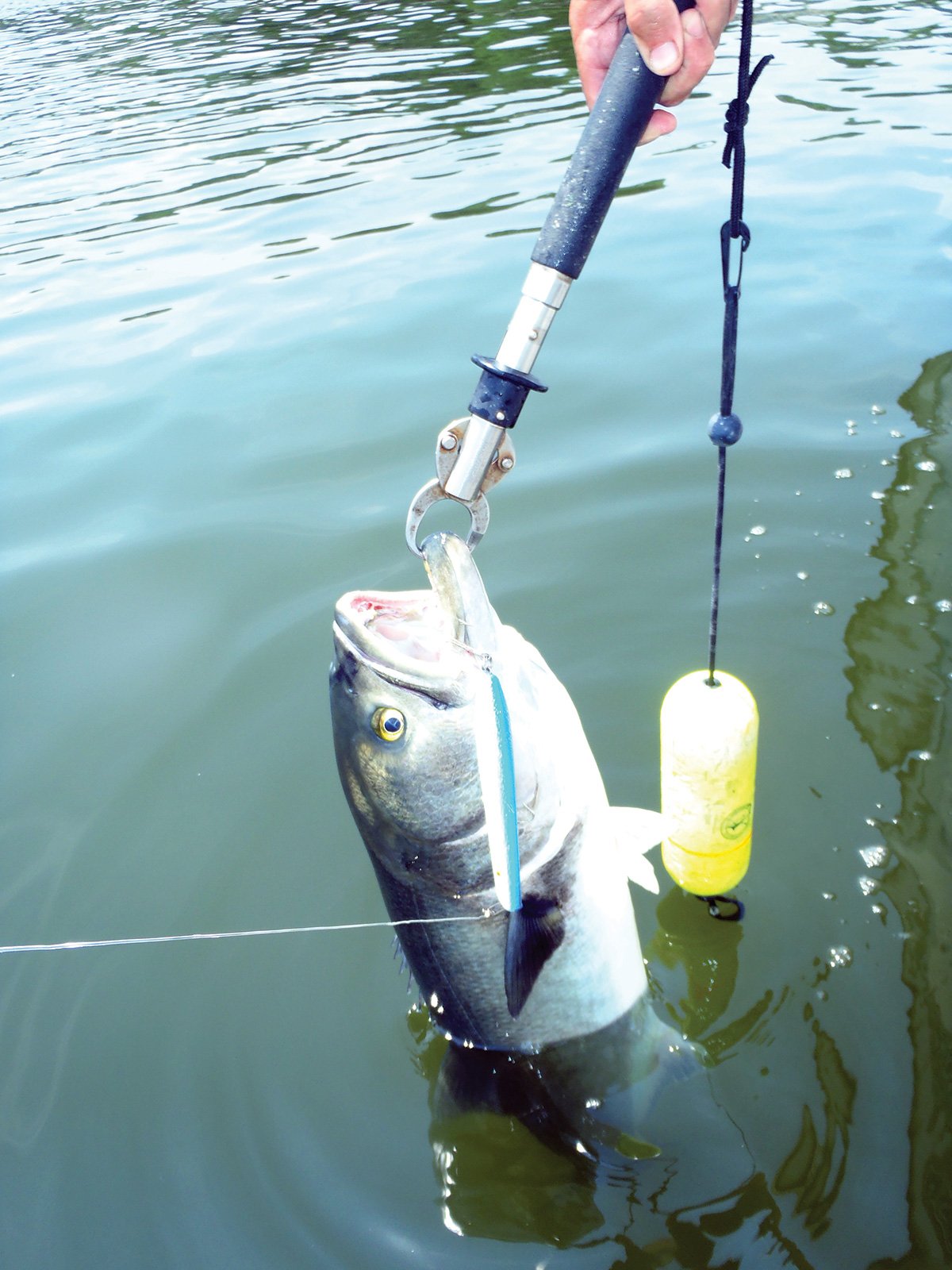
Western Sound Harbors
Blues are equal opportunity harbor visitors, and they tend to follow large schools of bait from one harbor to the next. The bait as we’ve pointed out, tends to move either because of relentless bluefish attacks or weather changes; especially winds, but are also sometimes chased into the Sound. Although the blues can be found harassing bait in the Sound, we prefer to wait for their return rather than fish with the heavy tackle needed in deep water.
Although harbors on both sides of the Sound hold blues at one time or another, let’s focus on the western harbors on the south side of the Sound. These include Little Neck, Manhasset, Hempstead Harbor, and Cold Spring Harbor. Boaters who ply Little Neck, Manhasset, and Hempstead harbors can quickly survey them because the travel distance between them is short. We found that it isn’t unusual for all three harbors to be “hot” at the same time; especially in the early autumn, but it is more common that one harbor is on fire while the others have some fish. It is also common that when blues in Manhasset disappear, they frequently reappear in Little Neck Bay in the days following a hard-northwest wind.
Hempstead and Cold Spring harbors have something in common. Both have back pockets that are mostly high and dry at low tide, and therefore unlike the three coves to the west that produce best at lower stages of the tide, Hempstead and Cold Spring are often at their best in the back pockets during the last two hours of the flood and the first hour of the ebb. Hempstead Harbor, much like the other two is lacking in structure. Therefore, bait and blues often roam around in the open area, and sometimes relentlessly pursue the bait deeper and deeper into the harbor. However, except for extreme moon tides, the back areas in Little Neck and Manhasset hold at least a few feet of water. The combination of less water, cornered bait, and hungry blues can set up some amazing blitzes. However, in Hempstead Harbor the bait can only be pushed as far south as Bar Beach until the tide rises. Then, blues push bait into and past the narrow gap between Glenwood Landing and Bar beach, effectively trapping them in the back pocket. Because the blues can easily skedaddle as the tide falls but the bait must wait for the “all-clear” signal, oxygen levels sometimes fall quickly in warm summer water, and fish kills result. Giant kills of adult bunker were common in Hempstead in the 1980s because of a combination of huge schools of bunker and enormous numbers of roaming bluefish schools.
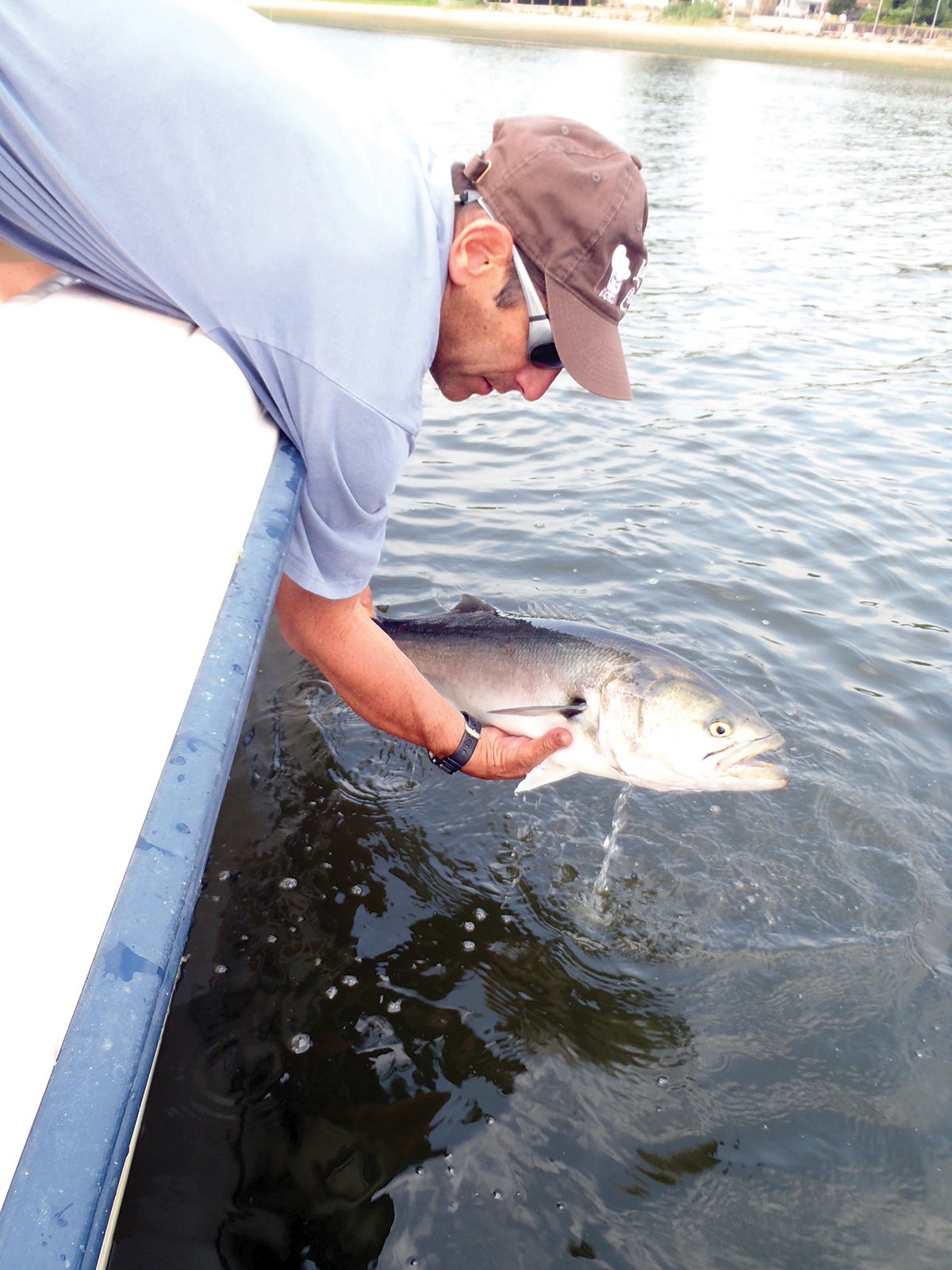
Gearing Up
Marc and Rich Lazar and I fish with 7-foot medium heavy power spinning rods with extra fast action tips and fitted with Van Staal 150 reels that are spooled with 20-pound test Sufix performance braid. This tackle combo allows us to make long casts with great accuracy, set hooks smartly, and fight even the largest blues efficiently. I’d advise that using any rod longer than 7 feet in a boat isn’t a good idea because longer rods become unwieldy; there’s just too much stuff around in a boat that can interfere with casting efficiency. I’ve seen more than one rod broken and antennae cracked by long rods. Seven-foot is the perfect compromise.
Plugging
Hard-nosed blues match up well with hard-nosed plugs. Although other lures such as bucktails and tins catch blues at higher tide levels, plying heavy lures in only 2 to 3 feet of water becomes a moot point. We have used Cotton Cordell 1-ounce pencil poppers under these conditions for several decades. They cast far, stand up to bluefish, and the blues love them. Of course, any 1-ounce pencil will catch fish, but we have found that the rattles in the Cordell pencils attract more strikes. We also use 1-1/2-ounce Super Strike Little Neck poppers as well as Smack-It poppers, but when the blues get a little finicky – and they do get finicky – the Cordell pencils produce more fish.
It’s curious how the mood of bluefish changes from hour to hour and day to day. Sometimes, they prefer a slow side to side sloshing action, while at other times they seem to insist on what Rich calls a “warp speed” walk the dog retrieve. Similarly, when using standard poppers, there are days when they want big splashes as you pop the lure, and other days when they want the pops subtler and slower. When they want slow speed, I switch from the black eye Super Strike to the green eye floating version so I cannot only move it slower without having the lure start to sink, but also pause the retrieve. I never cease to be amazed how blues in the “slow” mood will hit the popper while it’s just sitting on the surface motionless. Try this on a “warp speed” day and they simply turn and swim away. Each trip we explore their mood; observing the response and behavior of the blues to our lures and how we retrieve them before settling on what is, at least for a while, the “best” retrieve.
Fighting big blues in shallow quiet water has a way of disturbing the blues at times, and they begin to slink away or turn off to our lures. Much like fishing for spotted bass on deep water freshwater lakes, the fish scatter after several are caught, and the angler should retreat to another spot the fish frequent. However, it should be noted that if you allow the first area to rest for an hour or so, you can return to the first spot and if the bait is still there, begin catching fish again.
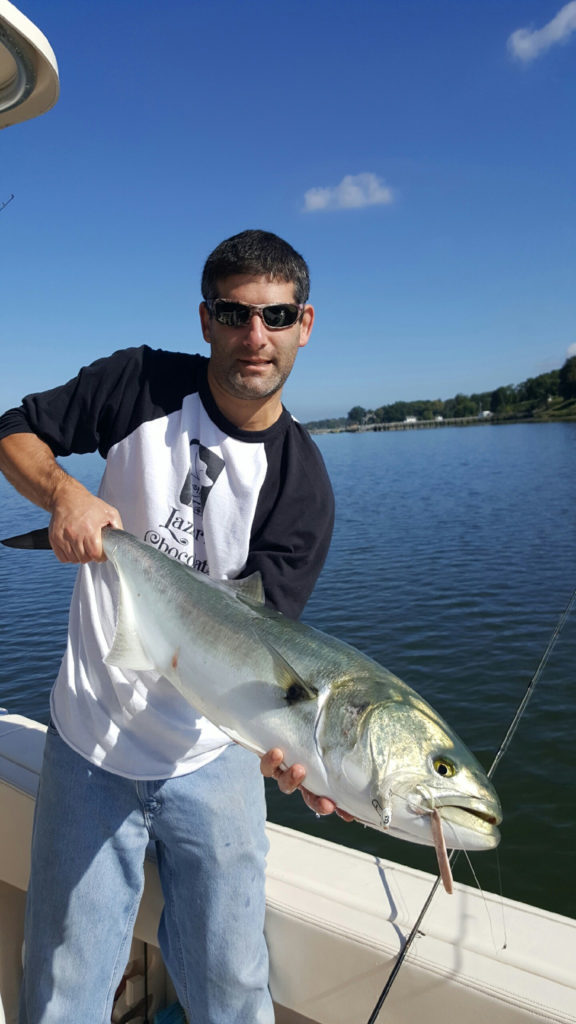
Stealth
Without a doubt a stealth strategy are essential. We have watched boats charge about; either because they are joy riding or in a hurry to get on fish, and the results are always bad, as well as infuriating. We know we must be quiet and careful. Our tackle allows us to make long casts, so we stay off the feeding activity. When we search for bait we run the four-cycle engine at idle speed and do not increase or decrease our speed. We must be, and are, patient as we look for even the subtlest signs of bait or feeding fish.
There’s no doubt that modern technology has created tackle, engines, and lures that make light tackle fishing for these big blues possible, and boy do we enjoy it. But keep in mind that we can only continue to enjoy these fishing experiences if we are judicious about our harvest. Harvest a few to eat and carefully release the rest for another day’s light tackle action.

